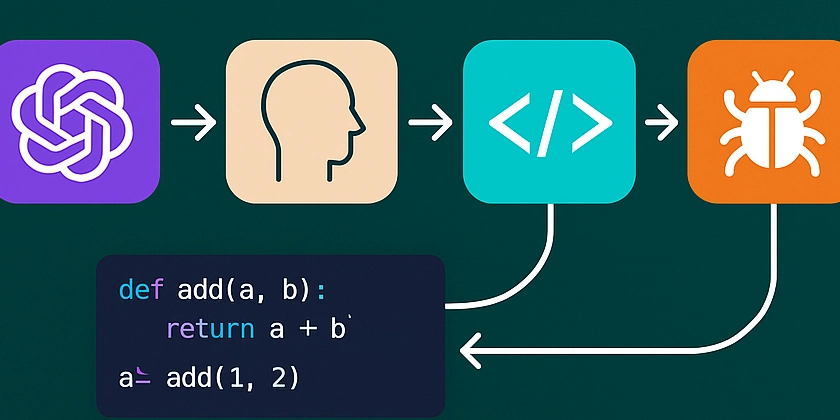Smarter Debugging with Chained LLMs: A Practical Guide
Why Debugging with One Model Isn't Enough Modern codebases are big. Really big. And so are the bugs. While LLMs like GPT-4 or Claude are amazing assistants, expecting one model to instantly fix any problem is like asking a mechanic to rebuild your car engine blindfolded, with only your description of the weird noise it makes. The smarter way? Let multiple LLMs collaborate — like a software doctor's team: one observes symptoms, one diagnoses, one prescribes treatment, and another verifies the recovery. This isn’t just theory — it works. Let’s break it down into a practical and repeatable system. The Multi-LLM Debugging Workflow in 5 Stages We'll assign each LLM a clear role. This improves focus, reduces hallucination, and increases debugging quality. 1. Clarify the Bug (GPT-4 or Claude) The first job is to understand what’s going wrong. Prompt Example: bug_report = """ User clicks 'Save', but nothing happens. JS console shows 'Uncaught TypeError: cannot read properties of undefined (reading \"email\")' """ prompt = f"Please summarize this bug and list 2-3 likely causes in a React app.\n\n{bug_report}" gpt_response = gpt4.generate(prompt) Real-world payoff: This helps junior devs, who may misinterpret vague bug descriptions, get a clear starting point. 2. Trace the Faulty Code (Claude for long context) Now that we understand the issue, we need to find where it happens. Claude excels here thanks to its large context window. You can paste in entire files. Prompt Example: full_component_code = open("UserForm.jsx").read() prompt = f""" Here's the full code for the component likely related to the bug. The error mentioned relates to `user.email`. Can you find where this might be undefined? {full_component_code} """ claude_response = claude.generate(prompt) Real-world payoff: Saves hours of grepping or guessing which prop or state is missing. 3. Investigate the Cause (GPT-4 or Claude) We now give the suspicious function or lines of code and let the model reason about what's wrong. Prompt Example: snippet = """ function handleSave(user) { console.log(user.email.toLowerCase()); } """ prompt = f"Analyze this function. Why might 'user.email' be undefined?" gpt_response = gpt4.generate(prompt) The user parameter might be null or not contain an email field. You should check if (user && user.email) before calling .toLowerCase(). 4. Generate the Fix (CodeWhisperer or GPT-4) Once the root cause is identified, generate a fix with minimal disruption. Example Prompt to CodeWhisperer (inside VS Code): // BUG: user or email might be undefined function handleSave(user) { // FIX HERE console.log(user.email.toLowerCase()); } Expected Completion: if (user && user.email) { console.log(user.email.toLowerCase()); } else { console.warn("User email is missing"); } Real-world payoff: Fast, stylistically consistent fix, ready to commit. 5. Review and Confirm (Second Pass via Claude) Never trust code blindly — even from GPT. Let another model (or the same one with a fresh prompt) verify that the change addresses the original bug and doesn’t break anything. Prompt Example: ew_code = """ function handleSave(user) { if (user && user.email) { console.log(user.email.toLowerCase()); } else { console.warn("User email is missing"); } } """ prompt = f""" Please review the following code. Does it safely handle the previous error: 'Cannot read property \"email\" of undefined'? {new_code} """ claude_review = claude.generate(prompt) Real-world payoff: Think of it like an automatic code reviewer — less pressure on your teammates, faster merges. Bonus: Auto-Chaining with LangChain Want to automate the entire pipeline? Sample Chain: from langchain.chains import SimpleSequentialChain step1 = LLMChain(llm=gpt4, prompt=clarify_bug_prompt) step2 = LLMChain(llm=claude, prompt=find_faulty_code_prompt) step3 = LLMChain(llm=gpt4, prompt=diagnose_bug_prompt) step4 = LLMChain(llm=codewhisperer, prompt=fix_code_prompt) step5 = LLMChain(llm=claude, prompt=review_prompt) debug_chain = SimpleSequentialChain(chains=[step1, step2, step3, step4, step5]) result = debug_chain.run("Bug: form crashes on submission") Final Thoughts Debugging isn't just about fixing bugs — it’s about understanding code, learning from mistakes, and improving systems. LLMs won’t replace developers — but they can act like your ultra-focused debugging teammates. By chaining their strengths, you get: Clarity from confusion. Reasoning before rushing. Safer fixes, faster reviews. TL;DR: Don’t use just one AI brain. Use many, smartly. :)

Why Debugging with One Model Isn't Enough
Modern codebases are big. Really big. And so are the bugs. While LLMs like GPT-4 or Claude are amazing assistants, expecting one model to instantly fix any problem is like asking a mechanic to rebuild your car engine blindfolded, with only your description of the weird noise it makes.
The smarter way? Let multiple LLMs collaborate — like a software doctor's team: one observes symptoms, one diagnoses, one prescribes treatment, and another verifies the recovery. This isn’t just theory — it works.
Let’s break it down into a practical and repeatable system.
The Multi-LLM Debugging Workflow in 5 Stages
We'll assign each LLM a clear role. This improves focus, reduces hallucination, and increases debugging quality.
1. Clarify the Bug (GPT-4 or Claude)
The first job is to understand what’s going wrong.
Prompt Example:
bug_report = """
User clicks 'Save', but nothing happens. JS console shows 'Uncaught TypeError: cannot read properties of undefined (reading \"email\")'
"""
prompt = f"Please summarize this bug and list 2-3 likely causes in a React app.\n\n{bug_report}"
gpt_response = gpt4.generate(prompt)
Real-world payoff: This helps junior devs, who may misinterpret vague bug descriptions, get a clear starting point.
2. Trace the Faulty Code (Claude for long context)
Now that we understand the issue, we need to find where it happens.
Claude excels here thanks to its large context window. You can paste in entire files.
Prompt Example:
full_component_code = open("UserForm.jsx").read()
prompt = f"""
Here's the full code for the component likely related to the bug. The error mentioned relates to `user.email`. Can you find where this might be undefined?
{full_component_code}
"""
claude_response = claude.generate(prompt)
Real-world payoff: Saves hours of grepping or guessing which prop or state is missing.
3. Investigate the Cause (GPT-4 or Claude)
We now give the suspicious function or lines of code and let the model reason about what's wrong.
Prompt Example:
snippet = """
function handleSave(user) {
console.log(user.email.toLowerCase());
}
"""
prompt = f"Analyze this function. Why might 'user.email' be undefined?"
gpt_response = gpt4.generate(prompt)
The
userparameter might be null or not contain anif (user && user.email)before calling.toLowerCase().
4. Generate the Fix (CodeWhisperer or GPT-4)
Once the root cause is identified, generate a fix with minimal disruption.
Example Prompt to CodeWhisperer (inside VS Code):
// BUG: user or email might be undefined
function handleSave(user) {
// FIX HERE
console.log(user.email.toLowerCase());
}
Expected Completion:
if (user && user.email) {
console.log(user.email.toLowerCase());
} else {
console.warn("User email is missing");
}
Real-world payoff: Fast, stylistically consistent fix, ready to commit.
5. Review and Confirm (Second Pass via Claude)
Never trust code blindly — even from GPT.
Let another model (or the same one with a fresh prompt) verify that the change addresses the original bug and doesn’t break anything.
Prompt Example:
ew_code = """
function handleSave(user) {
if (user && user.email) {
console.log(user.email.toLowerCase());
} else {
console.warn("User email is missing");
}
}
"""
prompt = f"""
Please review the following code. Does it safely handle the previous error: 'Cannot read property \"email\" of undefined'?
{new_code}
"""
claude_review = claude.generate(prompt)
Real-world payoff: Think of it like an automatic code reviewer — less pressure on your teammates, faster merges.
Bonus: Auto-Chaining with LangChain
Want to automate the entire pipeline?
Sample Chain:
from langchain.chains import SimpleSequentialChain
step1 = LLMChain(llm=gpt4, prompt=clarify_bug_prompt)
step2 = LLMChain(llm=claude, prompt=find_faulty_code_prompt)
step3 = LLMChain(llm=gpt4, prompt=diagnose_bug_prompt)
step4 = LLMChain(llm=codewhisperer, prompt=fix_code_prompt)
step5 = LLMChain(llm=claude, prompt=review_prompt)
debug_chain = SimpleSequentialChain(chains=[step1, step2, step3, step4, step5])
result = debug_chain.run("Bug: form crashes on submission")
Final Thoughts
Debugging isn't just about fixing bugs — it’s about understanding code, learning from mistakes, and improving systems. LLMs won’t replace developers — but they can act like your ultra-focused debugging teammates.
- By chaining their strengths, you get:
- Clarity from confusion.
- Reasoning before rushing.
- Safer fixes, faster reviews.
TL;DR: Don’t use just one AI brain. Use many, smartly. :)





























![[Webinar] AI Is Already Inside Your SaaS Stack — Learn How to Prevent the Next Silent Breach](https://blogger.googleusercontent.com/img/b/R29vZ2xl/AVvXsEiOWn65wd33dg2uO99NrtKbpYLfcepwOLidQDMls0HXKlA91k6HURluRA4WXgJRAZldEe1VReMQZyyYt1PgnoAn5JPpILsWlXIzmrBSs_TBoyPwO7hZrWouBg2-O3mdeoeSGY-l9_bsZB7vbpKjTSvG93zNytjxgTaMPqo9iq9Z5pGa05CJOs9uXpwHFT4/s1600/ai-cyber.jpg?#)










































































































































![[The AI Show Episode 144]: ChatGPT’s New Memory, Shopify CEO’s Leaked “AI First” Memo, Google Cloud Next Releases, o3 and o4-mini Coming Soon & Llama 4’s Rocky Launch](https://www.marketingaiinstitute.com/hubfs/ep%20144%20cover.png)





























































































































![[FREE EBOOKS] Machine Learning Hero, AI-Assisted Programming for Web and Machine Learning & Four More Best Selling Titles](https://www.javacodegeeks.com/wp-content/uploads/2012/12/jcg-logo.jpg)








































































![Rogue Company Elite tier list of best characters [April 2025]](https://media.pocketgamer.com/artwork/na-33136-1657102075/rogue-company-ios-android-tier-cover.jpg?#)








































































_Andreas_Prott_Alamy.jpg?width=1280&auto=webp&quality=80&disable=upscale#)






























































































![What’s new in Android’s April 2025 Google System Updates [U: 4/18]](https://i0.wp.com/9to5google.com/wp-content/uploads/sites/4/2025/01/google-play-services-3.jpg?resize=1200%2C628&quality=82&strip=all&ssl=1)










![Apple Watch Series 10 Back On Sale for $299! [Lowest Price Ever]](https://www.iclarified.com/images/news/96657/96657/96657-640.jpg)
![EU Postpones Apple App Store Fines Amid Tariff Negotiations [Report]](https://www.iclarified.com/images/news/97068/97068/97068-640.jpg)
![Apple Slips to Fifth in China's Smartphone Market with 9% Decline [Report]](https://www.iclarified.com/images/news/97065/97065/97065-640.jpg)




































































































































